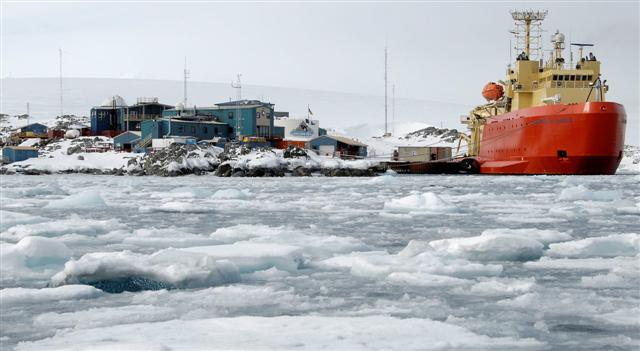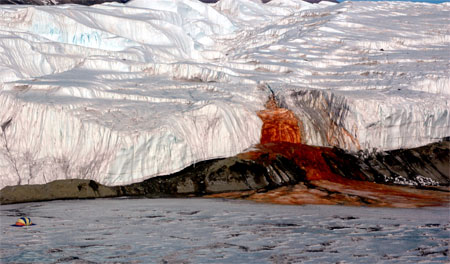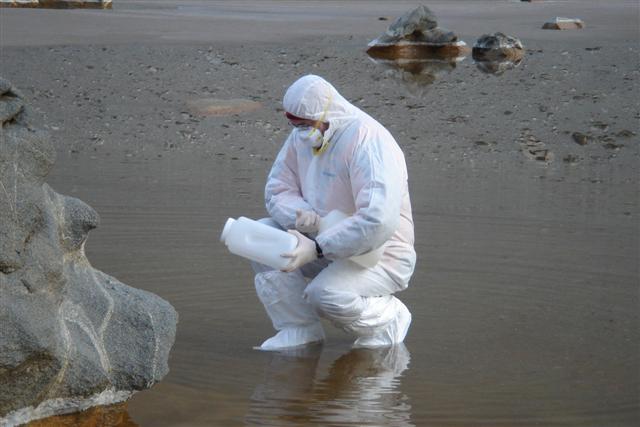|
Page 2/2 - Posted September 9, 2011
USAP also revising ASMA plans for sites around South Pole, PalmerWhile the thrust of all that high-tech mapping and geospatial information system (GIS) data collection is on environmental protection, Biletnikoff noted that the work also has scientific applications. For example, the maps that PGC are producing are so accurate that researchers can monitor lake levels in the Dry Valleys from one year to the next. “We have long-term ecological monitoring ability,” he said. “PGC has the ability to pull images at any given time for almost any given place on the Antarctic continent.” 
Photo Credit: ERA/Digitized from Digital Globe imagery
A map of the Don Juan Pond restricted zone created from high-resolution satellite imagery.
The Taylor Valley is the site of a nearly 20-year study called the McMurdo Dry Valleys Long Term Ecological Research The revised management plan identifies scientific zones and restricted zones, which used to be grouped under the more general term of special features. “There’s ongoing scientific research in those particular zones that other people should be aware of, so when they’re planning to go to those areas they don’t interrupt or harm the types of data being collected out there,” Biletnikoff said. Restricted zones are sites of high scientific value that are particularly sensitive to human disturbance. For example, Don Juan Pond in Wright Valley boasts a salinity level of about 40 percent, making it the most saline natural body of water on the planet. The management plan also lists previous activities at the site — such as a borehole that was drilled adjacent to the pond — and restrictions for helicopter operations in the area. 
Photo Credit: Andrew V. Williams/Antarctic Photo Library
The marine area around Palmer Station is another ASMA.
The USAP has additionally taken the lead on the ASMA management plans at two other locations — the geographic South Pole and a marine area designated as Southwest Anvers Island and Palmer Basin — where it maintains research facilities. Biletnikoff said his team would continue revising both of those plans next fiscal year. One focus for the former will be on ensuring that the installation of new high-tech projects at the South Pole Station The Palmer ASMA plan revisions include an ambitious effort to collect detailed ground data on the location of seabird communities and other sensitive areas within the 2,700-square kilometers of the protected area. “One particular aspect we are focusing on recently that is related to the ASMA management plan is oil spill contingency planning and response,” Biletnikoff said. The area has a high volume of vessel traffic from several other national Antarctic programs, as well as tour ships. The goal is to be able to determine the possible effects from an oil spill in the region based on data about prevailing ocean currents, islands in the vicinity and wildlife locations. “In the event of a spill, this in turn will help prioritize which areas are likely to require response measures first and how best to manage available resources,” he explained. 
Photo Credit: Peter Rejcek/Antarctic Photo Library
The USAP will propose making Blood Falls in the McMurdo Dry Valleys an ASPA.
The coming year will also likely see the United States propose a new Antarctic Specially Protected Area (ASPA) to the ATCM in 2012. An ASPA protects outstanding environmental, scientific, historic, aesthetic or wilderness values, or a combination of those values, or ongoing or planned scientific research. A permit is required to enter an ASPA. Currently, there are 71 ASPAs around the Antarctic. Blood Falls could become No. 72, if approved by the Antarctic Treaty nations. Blood Falls is a waterfall-like feature that flows from Taylor Glacier over Lake Bonney, one of several ice-covered lakes in the Dry Valleys. The falls are red because they draw water from an iron-rich pool beneath the glacier, where scientists have discovered a unique microbial community. [See previous article: Ancient microbes.] Biletnikoff said discussions are still under way to define the boundary of the proposed ASPA. “We want to ensure that we’re protecting this natural resource but at the same time we need to establish consensus on the extent of the area based on the best available scientific evidence.”Back 1 2 |



For USAP Participants |
For The Public |
For Researchers and EducatorsContact UsNational Science FoundationOffice of Polar Programs Geosciences Directorate 2415 Eisenhower Avenue, Suite W7100 Alexandria, VA 22314 Sign up for the NSF Office of Polar Programs newsletter and events. Feedback Form |


